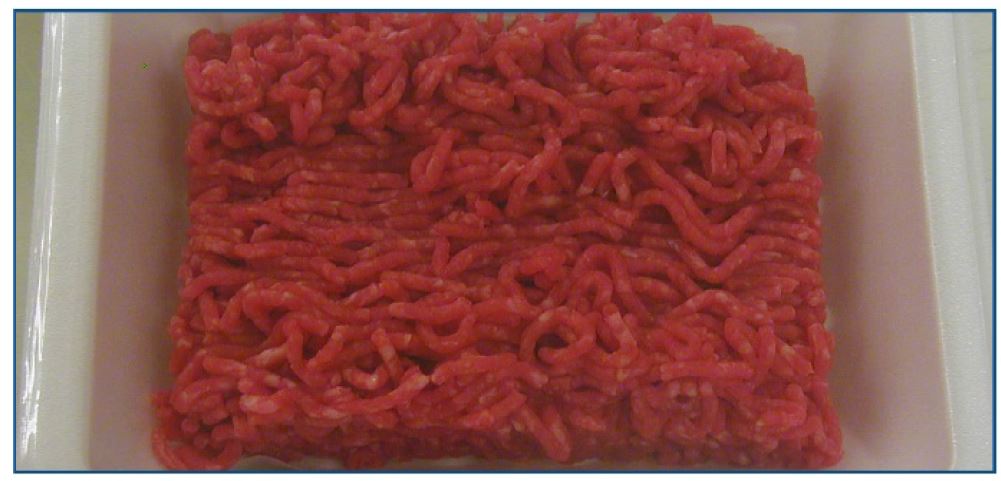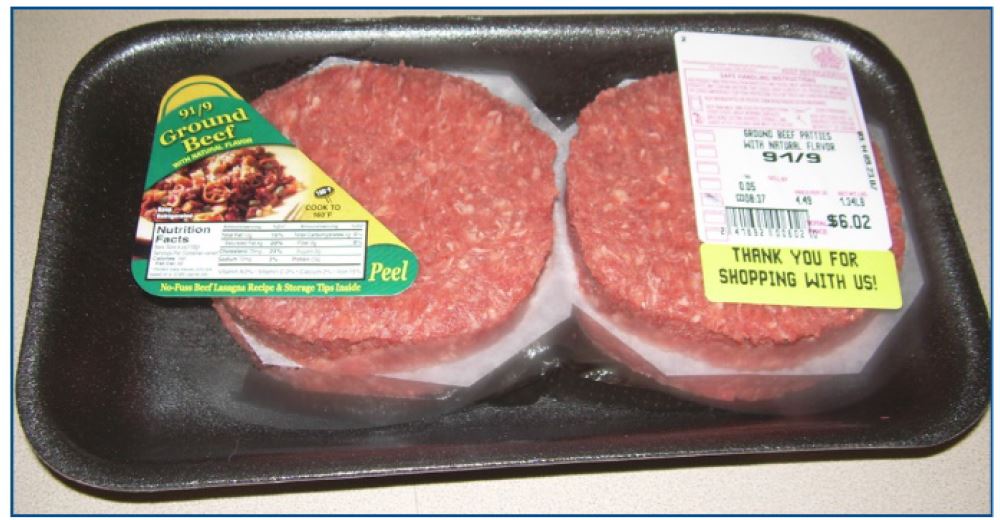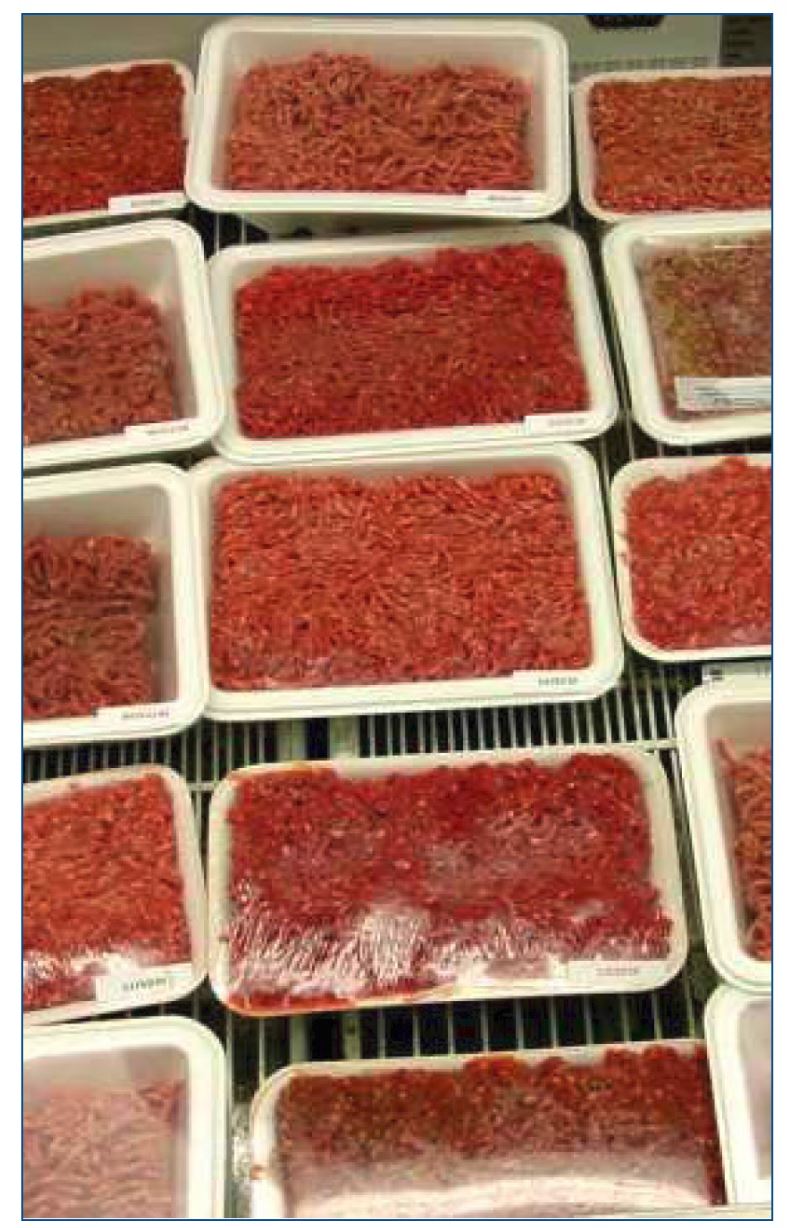Fresh beef accounts for approximately 4 billion pounds and $15 billion in sales annually. Because the beef industry serves many markets, numerous demands are placed on the manufacture, distribution, sales and marketing of beef products to multiple segments of the food industry. To supply safe, high quality fresh products to its customers, the beef industry utilizes a range of packaging technologies. Beef packages must perform several functions. Packages must protect against contamination and deterioration, provide product visibility, and display label information. Packages also serve a merchandising function and must be appealing to consumers.
The multiple functions and variety of packaging technologies available for consumer products creates challenges for those who design packages for beef, including fresh, cooked or frozen beef products. Beef packaging may be stored under a wide range of conditions including refrigeration, freezing and intense lighting, and it must be able to withstand these conditions and handling abuse.
Regardless of its purpose, the package must be economical to produce to keep cost low and maintain beef’s competitiveness among sources of dietary protein.
Meat Color
In order to understand meat packaging, it is important to understand the needs of the beef product being marketed. Research has shown that meat color is a primary factor affecting consumer purchase decisions and the most favorable meat color is red. Beef can naturally exist in many colors; including red, purple and brown as well as yellow and green. Meat contains the protein myoglobin, which is responsible for meat color and a change in myoglobin results in a change in meat color. Within its structure, myoglobin contains iron and a binding site for various biochemical components to attach. The state of the iron and the nature of the components attached to the binding site determine the color of meat.
U.S. consumers associate bright red beef with wholesomeness and any deviation from this color could be detrimental to the marketing of fresh beef to consumers. However, once developed, the red beef color is not permanent. The amount of time beef maintains its bright red appearance in the grocery store is referred to as color shelf-life or case-life.
Case-Life
Consumers have several indicators available to determine beef freshness and quality. In addition to color and odor changes associated with the end of case-life, code dates are included on fresh beef packaging labels. Code dates indicate when a package should be sold by or consumed by to ensure freshness.
Case-life is limited because exposure to oxygen is required for beef to become red in color. Once exposed to oxygen, a natural process of chemical reactions begins, which is called oxidation. Oxygen in the air is transformed and begins to affect lipids and proteins in the meat. This results in chemical changes that adversely affect the color, odor and taste of meat products. Oxidized meat products are brown in color, have a tendency to smell like cardboard and taste rancid. The best indicator of oxidation in meat products at the point of purchase in a retail store is the development of brown spots on the lean surface.
Another factor limiting the case-life of beef is the growth of spoilage bacteria. These bacteria are classified as spoilage bacteria because they contribute to the spoilage of beef products, but do not cause illness like pathogenic bacteria. Beef products contain low levels of spoilage bacteria after processing. Bacteria must grow and reproduce to substantial numbers to cause a decrease in case-life. Typically, the bacteria responsible for the spoilage of meat are those that find the environmental conditions favorable for growth.
Environmental conditions that affect the growth of bacteria can include storage temperature, moisture availability, initial bacteria levels, nutrient availability and the physical state of the meat product (ground beef vs. beef steaks). Spoilage bacteria that find conditions most favorable will begin to grow even at refrigerated temperatures. Meat is an excellent source of the nutrients that spoilage bacteria need to survive and grow. Beef is also high in moisture and protein. Once the low levels of glucose in meat are consumed by the bacteria, beef proteins will be targeted. Bacteria use the proteins for growth which results in the development of by-products. These by-products then react with myoglobin causing beef to turn brown, yellow or green in color. It should be noted that the growth of spoilage bacteria is slow at refrigerated temperatures and oxidation usually results in discoloration before the development of by-products from bacterial growth.
Package Types
Beef retailers use a wide variety of packaging to merchandize fresh beef. A general category of packages known as case-ready has increased in numbers over that last few years. Case-ready simply describes a package sent from the beef processing facility that requires no repackaging in the store before being placed in the meat case. Case-ready packages contain a USDA inspection insignia on the package, which includes the exclusive USDA establishment number assigned to the processor that packaged the beef. Several types of case-ready packaging are available, including modified-atmosphere and vacuum packages.


Photos courtesy of Colorado State University.
Modified Atmosphere Packaging
Modified atmosphere packages house beef products in an environment other than air. Modified atmosphere packages typically are described as rigid plastic trays, which hold the beef product and an absorbent pad, sealed with a clear high-barrier plastic film. During the manufacturing of these packages, a machine will vacuum residual air from the tray and then flush the tray with a modified atmosphere immediately prior to sealing the package with the clear film. The modified atmospheres typically contain purified gases found in air (oxygen, carbon dioxide, nitrogen and/or carbon monoxide) and each gas has a distinct use or purpose. Nitrogen has no effect on meat color or bacteria growth, but is used as a dilutant allowing other gases to be used in proper ratio. Oxygen is used because it causes the bright red color consumers prefer. Carbon dioxide is used to decrease or prohibit the growth of spoilage bacteria. Carbon monoxide was approved for use in 2002 by the FDA and USDA at a level of 0.4% and works with myoglobin to form a strong bond that creates a red color. Carbon monoxide is approved for use in a gas mixture that does not include oxygen and the result is a decrease in oxidation, which creates a stabilizing effect and increases case-life. The most common modified atmospheres consist of 80% oxygen / 20% carbon dioxide or 0.4% carbon monoxide / 30% carbon dioxide / 69.6% nitrogen.

Photo courtesy of Colorado State University
VACUUM PACKAGING
Another form of modified atmosphere packaging is vacuum packaging. This packaging method involves the use of a plastic pouch or bag made from materials that provide a strong barrier of protection against abrasion, moisture migration and gas permeability. Beef cuts are placed inside the plastic pouch, placed in a packaging machine that removes the residual air from the pouch and immediately seals the pouch to prevent air from returning to the package. The vacuum-packaged beef is usually placed in hot water for a brief time, which causes the excess edges of the pouch to shrink around the beef cut; improving the appearance and strength of the package. Because vacuum packaging removes the oxygen from the package, vacuum packaged beef cuts usually are purple-brown in color. Consumers are not accustomed to purchasing purple colored fresh beef, so vacuum packaging at retail is typically reserved for beef cuts that have a permanently fixed color. Fixed beef colors can result from cooking or curing. In recent years, consumers have begun to accept the vacuum packaging of a few beef cuts, including beef brisket. The lack of oxygen in the package greatly increases the case-life of vacuum packaged beef because of decreased oxidation.
TRADITIONAL PACKAGING
The most common form of fresh meat packaging at retail is called store wrap. Surveys show that approximately two-thirds of fresh meat packages are store wrap, but this number is declining each year due to the availability of case-ready packaging. This packaging technique received its namesake because bulk, vacuum-packaged beef is delivered, portioned and repackaged for display when it arrives at the retail store. The package consists of a foam tray, which holds the beef and absorbent pad, wrapped with a clear atmosphere-permeable plastic film. The permeability characteristics of the film allow oxygen from the air to come in contact with the beef; changing the color of the beef from purple to red. This package type is very economical and utilizes cost-effective equipment. However, it possesses the shortest case-life among package types because the continued exposure to oxygen promotes oxidation and the lack of significant levels of carbon dioxide in air does not suppress spoilage bacteria growth. Other types of beef packaging can be found in the retail case. However, these package types can generally be classified as a form of vacuum packing or gas-flush modified atmosphere packaging.
Safety
Recent advances in case-ready packaging provide increased case-life as well as the opportunity for increased safety. Great strides have been made to increase the safety of beef products through the reduction of pathogenic (illness causing) bacteria. However, opportunities exist for processors to ensure the United States not only has the safest food supply in the world, but to routinely benchmark new standards of safety. Recent research has shown gas-flush modified atmosphere packaging decreases levels of harmful pathogenic bacteria in controlled, laboratory studies. On-going studies also are investigating the use of beneficial bacteria (like those used in yogurt) in ground beef to destroy pathogens that may be present in beef.
The United States continues to enjoy the safest food supply in the world. Because of technological advances funded and investigated by dedicated industry and government entities, U.S. consumers continue to enjoy wholesome, nutritious beef products with enhanced quality and longer shelf-life.
References
-
Aberle, E.D., Forrest, J.C., Gerrard, D.E., Mills, E.W., Hedrick, H.B., Judge, M.D. and R.A. Merkel. Principles of Meat Science. 4th Edition. Kendall/Hunt Publishing Company; Dubuque, Iowa. ISBN 0-7872-4720-0.
- Brooks, J.C., Alvarado, M., Stephens, T.P., Kellermeier, J.D., Tittor, A.W., Miller, M.F. and M.M. Brashears. 2007. The Spoilage and Safety Characteristics of Ground Beef Packaged in High- Oxygen and Low-Oxygen Modified Atmosphere Packages. Submitted to the Journal of Food Protection – in review.
- Farber, J.M. 1991. Microbiological aspects of modified-atmosphere packaging technology – a review. J Food Prot. 54:58-70.
- Gill, C.O. 1986. The control of microbial spoilage in fresh meats. In Advances in Meat Research Vol. 2 Meat and Poultry Microbiology, pp. 49-88.
- Lambert, A.D., Smith, J.P. and Dodds, K.L. 1991. Shelf life extension and microbiological safety of fresh meat – A review. Food Microbiol. 8:267-297.
- Mancini, R.A. and Hunt, M.C. 2005. Current Research in Meat Color. Meat Science 71:100-121.
- Nassos, P.S., King, A.D.,Jr. and A.E. Stafford. 1983. Relationship between lactic acid concentration and bacterial spoilage in ground beef. Appl Environ Microbiol. 46:894-900.
- National Cattlemen’s Beef Association. 2004 National Meat Case Composite Study: Today’s Retail Meat Case, Evolving Trends Across the Country. Accessed at: http://www.beefretail.org/uDocs/consumertrendsbrochure512.pdf on June 20, 2005.
- National Cattlemen’s Beef Association: Sales and Featuring Trends. Accessed at: http://www.beefretail.org/reseSalesFeaturingTrends.aspx on May 15, 2007.
- O’Connor-Shaw, R.E. and Reyes, V.G. 2000. Use of modified-atmosphere packaging. In Encyclopedia of Food Microbiology (R.K. Robinson, C.A. Batt, and P.D. Patel, editors), pp. 410-416. Academic Press: San Diego.